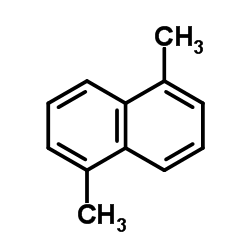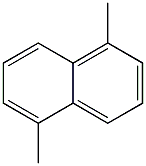1,5-二甲基萘, >99.0%(GC),1,5-Dimethylnaphthalene
产品编号:西域试剂-WR376584| CAS NO:571-61-9| MDL NO:MFCD00004038| 分子式:C12H12| 分子量:156.23
本网站销售的所有产品仅用于工业应用或者科学研究等非医疗目的,不可用于人类或动物的临床诊断或者治疗,非药用,非食用,
| 英文名称 | 1,5-Dimethylnaphthalene |
|---|---|
| CAS编号 | 571-61-9 |
| 产品熔点 | 77-82 °C(lit.) |
| 产品沸点 | 265.6±10.0 °C at 760 mmHg |
| 产品密度 | 1.0±0.1 g/cm3 |
| 产品闪点 | 111.4±9.7 °C |
| 精确质量 | 156.093903 |
| LogP | 4.37 |
| 蒸气压 | 0.0±0.3 mmHg at 25°C |
| 折射率 | 1.605 |
| 稳定性 | 稳定性和反应性: 1.要避免的物料:氧化物。 2.要分解的产品:一氧化碳和二氧化碳。 3.存在于香料烟烟叶、烟气中。 |
| 储存条件 | 贮存: 将密器密封,储存密封的主藏器内,并放在阴凉, 干爽的位置。 |
相关文档
化学品安全说明书(MSDS)
下载MSDS质检证书(COA)
相关产品
| 危害码 (欧洲) | Xi |
|---|---|
| 风险声明 (欧洲) | 36/37/38 |
| 安全声明 (欧洲) | S26-S36 |
| WGK德国 | 3 |
| 海关编码 | 2902909090 |
|
Section I.Chemical Product and Company Identification Chemical Name 1,5-Dimethylnaphthalene Portland OR SynonymNot available. Chemical FormulaC10H6(CH3)2 CAS Number571-61-9 Section II.Composition and Information on Ingredients Chemical NameCAS Number Percent (%)TLV/PELToxicology Data 1,5-Dimethylnaphthalene571-61-9Min. 99.0(GC) Not available.Not available. Section III. Hazards Identification Acute Health EffectsIrritating to eyes and skin on contact. Inhalation causes irritation of the lungs and respiratory system. Inflammation of the eye is characterized by redness, watering, and itching. Skin inflammation is characterized by itching, scaling, reddening, or, occasionally, blistering. Follow safe industrial hygiene practices and always wear proper protective equipment when handling this compound. CARCINOGENIC EFFECTS : Not available. Chronic Health Effects MUTAGENIC EFFECTS : Not available. TERATOGENIC EFFECTS : Not available. DEVELOPMENTAL TOXICITY: Not available. Repeated or prolonged exposure to this compound is not known to aggravate existing medical conditions. Section IV.First Aid Measures Eye ContactCheck for and remove any contact lenses. In case of contact, immediately flush eyes with plenty of water for at least 15 minutes. Get medical attention. Skin ContactIn case of contact, immediately flush skin with plenty of water. Remove contaminated clothing and shoes. Wash clothing before reuse. Thoroughly clean shoes before reuse. Get medical attention. InhalationIf the victim is not breathing, perform mouth-to-mouth resuscitation. Loosen tight clothing such as a collar, tie, belt or waistband. If breathing is difficult, oxygen can be administered. Seek medical attention if respiration problems do not improve. IngestionINDUCE VOMITING by sticking finger in throat. Lower the head so that the vomit will not reenter the mouth and throat. Loosen tight clothing such as a collar, tie, belt or waistband. If the victim is not breathing, perform mouth-to-mouth resuscitation. Examine the lips and mouth to ascertain whether the tissues are damaged, a possible indication that the toxic material was ingested; the absence of such signs, however, is not conclusive. Section V.Fire and Explosion Data Auto-IgnitionNot available. FlammabilityMay be combustible at high temperature. Flammable Limits Flash PointsNot available. Not available. Combustion ProductsThese products are toxic carbon oxides (CO, CO 2). Fire Hazards Not available. Risks of explosion of the product in presence of mechanical impact: Not available. Explosion Hazards Risks of explosion of the product in presence of static discharge: Not available. Fire Fighting Media SMALL FIRE: Use DRY chemical powder. and InstructionsLARGE FIRE: Use water spray, fog or foam. DO NOT use water jet. Consult with local fire authorities before attempting large scale fire-fighting operations. Continued on Next Page 1,5-Dimethylnaphthalene Section VI.Accidental Release Measures Spill CleanupIrritating material. InstructionsUse a shovel to put the material into a convenient waste disposal container. Finish cleaning the spill by rinsing any contaminated surfaces with copious amounts of water. Consult federal, state, and/or local authorities for assistance on disposal. Section VII. Handling and Storage Handling and StorageIRRITANT. Keep away from heat. Mechanical exhaust required. When not in use, tightly seal the container and store in a dry, cool place. Avoid excessive heat and light. Do not breathe dust. Information Always store away from incompatible compounds such as oxidizing agents. Section VIII. Exposure Controls/Personal Protection Engineering ControlsUse process enclosures, local exhaust ventilation, or other engineering controls to keep airborne levels below recommended exposure limits. If user operations generate dust, fume or mist, use ventilation to keep exposure to airborne contaminants below the exposure limit. Personal ProtectionSplash goggles. Lab coat. Dust respirator. Boots. Gloves. Suggested protective clothing might not be sufficient; consult a specialist BEFORE handling this product. Be sure to use a MSHA/NIOSH approved respirator or equivalent. Exposure LimitsNot available. Section IX. Physical and Chemical Properties Solubility Physical state @ 20°CSolid. (White crystalline powder.)Not available. Not available. Specific Gravity Molecular Weight156.23Partition CoefficientNot available. Boiling Point265 to 266°C (509 to 510.8°F)Vapor PressureNot applicable. Melting Point80 to 82°C (176 to 179.6°F)Vapor DensityNot available. Not available.VolatilityNot available. Refractive Index Critical TemperatureOdorNot available. Not available. Not available.Not available. ViscosityTaste Section X.Stability and Reactivity Data This material is stable if stored under proper conditions. (See Section VII for instructions) Stability Conditions of Instability Avoid excessive heat and light. Incompatibilities Reactive with strong oxidizing agents. Section XI. Toxicological Information RTECS NumberNot available. Routes of ExposureEye Contact. Ingestion. Inhalation. Not available. Toxicity Data Chronic Toxic EffectsCARCINOGENIC EFFECTS : Not available. MUTAGENIC EFFECTS : Not available. TERATOGENIC EFFECTS : Not available. DEVELOPMENTAL TOXICITY: Not available. Repeated or prolonged exposure to this compound is not known to aggravate existing medical conditions. Irritating to eyes and skin on contact. Inhalation causes irritation of the lungs and respiratory system. Inflammation of the Acute Toxic Effects eye is characterized by redness, watering, and itching. Skin inflammation is characterized by itching, scaling, reddening, or, occasionally, blistering. Follow safe industrial hygiene practices and always wear proper protective equipment when handling this compound. Continued on Next Page 1,5-Dimethylnaphthalene Section XII.Ecological Information EcotoxicityNot available. Environmental FateNot available. Section XIII. Disposal Considerations Recycle to process, if possible. Consult your local regional authorities. You may be able to dissolve or mix material with a Waste Disposal combustible solvent and burn in a chemical incinerator equipped with an afterburner and scrubber system. Observe all federal, state and local regulations when disposing of the substance. Section XIV. Transport Information DOT ClassificationNot a DOT controlled material (United States). PIN NumberNot applicable. Proper Shipping Name Not applicable. Packing Group (PG)Not applicable. DOT Pictograms Section XV. Other Regulatory Information and Pictograms TSCA Chemical InventoryThis product is NOT on the EPA Toxic Substances Control Act (TSCA) inventory. The following notices are required by 40 CFR 720.36 (C) for those products not on the inventory list: (EPA) (i) These products are supplied solely for use in research and development by or under the supervision of a technically qualified individual as defined in 40 CFR 720.0 et sec. (ii) The health risks of these products have not been fully determined. Any information that is or becomes available will be supplied on an MSDS sheet. WHMIS ClassificationNot available. (Canada) EINECS Number (EEC) 209-338-5 EEC Risk StatementsR36/37/38- Irritating to eyes, respiratory system and skin. SECTION 16 - ADDITIONAL INFORMATION N/A |








 浙公网安备 33010802013016号
浙公网安备 33010802013016号